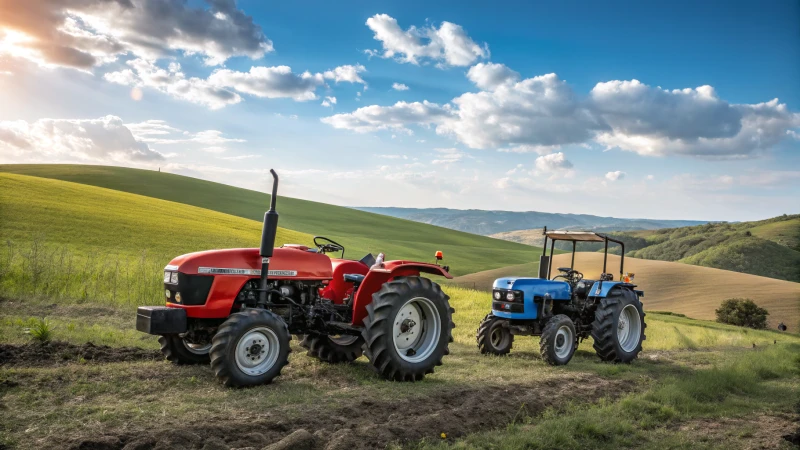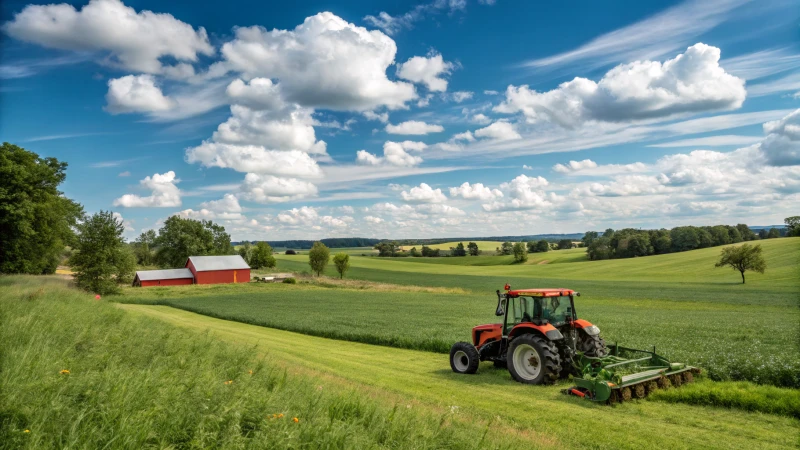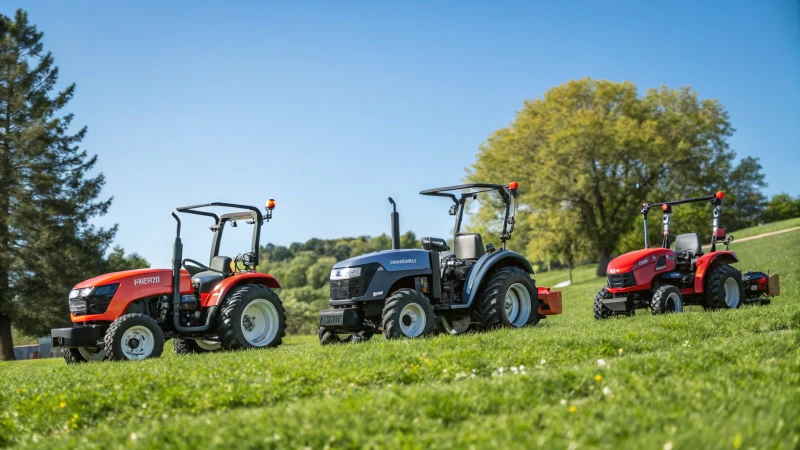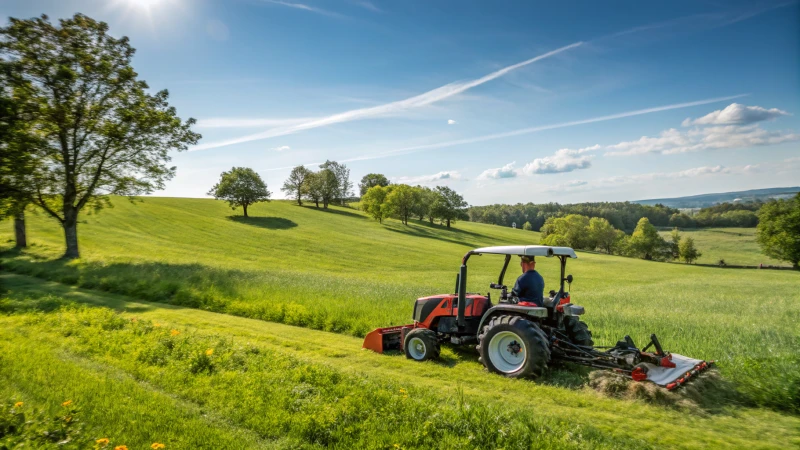Choosing the right tractor for a 5-acre property can make all the difference between a hobby and a hassle.
For a 5-acre farm, a compact or sub-compact tractor with 25 to 50 horsepower is ideal. These tractors strike the perfect balance for mowing, tilling, and hauling tasks, ensuring efficiency without unnecessary power or cost.
I remember when I first tackled my own 5-acre plot. I learned quickly that while compact tractors might seem an obvious choice, understanding the specifics of horsepower needs, tractor types, and essential attachments can save time and money. Let’s dive into these aspects so you can find the perfect tractor to transform your land into exactly what you envision.
Compact tractors are best for 5-acre farms.True
Compact tractors offer the right balance of power and versatility for small farms.
Sub-compact tractors are too costly for 5-acre farms.False
Sub-compact tractors are generally affordable, making them suitable for small farms.
How Much Horsepower Do You Really Need?
Ever sat behind the wheel and wondered, "How much horsepower do I really need?" It's a question that can save you both money and frustration if you get it right.
The amount of horsepower you need depends on your tractor and its purpose. On small farms, tractors with 25-50 HP are usually ideal.

Horsepower for Farm Equipment
| Type | Ideal Horsepower | Usage |
|---|---|---|
| Sub-Compact Tractors | 15-25 HP | Mowing, gardening |
| Compact Utility Tractors | 25-50 HP | Tilling, hauling |
| Full-Size Tractors | 50+ HP | Large-scale farming |
When More Isn’t Better
It's tempting to think more horsepower is always better, but that's not necessarily true. Higher horsepower often means higher costs and lower fuel efficiency.
- Small Farm Owners: For most tasks on a small farm, anything over 50 HP may be excessive unless you’re working with heavy implements regularly.
Considerations Beyond Horsepower
When it comes to horsepower, it's important to look at the whole picture:
- Terrain: Living in a hilly area myself, I know more power can be crucial for those steep climbs.
- Weather Conditions: Snowy or muddy conditions might require more horsepower for better traction—something I realized one winter when my farm tractor struggled on an icy hill.
- Towing Needs: If you frequently tow, that extra horsepower can really come in handy.
Understanding these aspects will help you make informed decisions when choosing the right horsepower for your needs. Avoiding the trap of going for the highest HP without consideration can save on costs and improve efficiency in the long run.
Should You Choose a Compact or Sub-Compact Tractor?
Ever stood in a field, gazing at the horizon, wondering which tractor is right for your land?
Deciding between a compact and sub-compact tractor depends on your property's size and task demands. Compact tractors handle heavier chores on expansive areas, while sub-compacts excel in lighter duties on smaller plots.

Understanding the Basics
I remember the first time I had to choose a tractor for my farm. I was knee-deep in brochures and specs, trying to make sense of horsepower and implement sizes. It felt overwhelming at first, but here’s what I learned.
A compact tractor, with its 25-50 HP range, is like the workhorse of tractors—ideal for those heavier jobs like plowing or heavy hauling1. On the other hand, sub-compact tractors are more like nimble assistants, sporting 15-25 HP and perfect for tasks like mowing or tilling a small garden.
| Feature | Compact Tractor | Sub-Compact Tractor |
|---|---|---|
| Horsepower (HP) | 25-50 HP | 15-25 HP |
| Best For | Heavy-duty work | Light-duty tasks |
| Typical Uses | Plowing, large-scale landscaping | Mowing, gardening |
Property Size Considerations
When I looked at my sprawling 5-acre property, it was clear that a compact tractor was the way to go—its versatility could handle everything I threw at it. But if you’re working with a cozy backyard or a small plot, a sub-compact might be your best friend.
Task-Specific Needs
Think about what you’ll be doing:
- Mowing: Both types can mow, but the size of the finish mower2 attachment can vary.
- Tilling: Larger implements need more power, so a compact model might be necessary.
- Material Handling: If you're constantly shifting heavy loads, the higher lift capacity of a compact tractor could be invaluable.
Cost and Maintenance Factors
Sub-compacts are generally easier on the wallet and require less upkeep, thanks to their simpler mechanics. However, I found that investing in a compact tractor paid off in the long run with its durability and efficiency for demanding tasks. It's all about balancing your budget with what you need your tractor to do.
In summary, choosing between these two types boils down to your land size, task requirements, and budget. Dive into tractor comparisons3 to uncover more about specific models and their capabilities. Trust me, taking the time to match your needs with the right machine will make all the difference.
Compact tractors have 25-50 HP.True
Compact tractors are designed for more intensive tasks with 25-50 HP.
Sub-compact tractors handle heavy-duty work well.False
Sub-compact tractors are suited for light-duty tasks, not heavy-duty work.
What Tasks Can Your Tractor Handle on a 5-Acre Farm?
Ever wondered what your trusty tractor can do on your 5-acre farm? It's more than just a big machine—it’s a versatile helper ready to tackle a variety of tasks, making your farming life easier and more efficient.
On my 5-acre farm, a compact or sub-compact tractor (25-50 HP) is a game-changer. It handles mowing, tilling, snow removal, and hauling effortlessly. By choosing the right attachments, I maximize its versatility and get more done with less effort.

Assessing Tractor Capacity for Common Farm Tasks
Mowing and Landscaping
I remember the first time I sat on my tractor to mow the fields. With a rotary cutter4 attachment, my sub-compact tractor (15-25 HP) glided across the terrain, even over those tricky patches I thought would be a challenge. It made me realize how much I could do in just an afternoon.
Tilling and Soil Preparation
Tilling was initially daunting. But with a rototiller attachment5 and my compact utility tractor (25-50 HP), I found breaking new ground wasn't as backbreaking as I'd imagined. The power behind it made preparing for planting feel like a breeze.
Material Handling
My compost heap seemed like an insurmountable task until I got a front-end loader. Now, moving compost or mulch feels almost effortless. My compact tractor, with its strength and agility, has turned this into one of my favorite tasks.
| Task | Tractor Type | Attachment |
|---|---|---|
| Mowing | Sub-Compact (15-25 HP) | Rotary Cutter |
| Tilling | Compact (25-50 HP) | Rototiller |
| Material Handling | Compact (25-50 HP) | Front-End Loader |
Snow Removal
Living where snow can pile up quickly, having a snow blower or blade attachment has been invaluable. My compact tractor clears paths efficiently, saving me from early morning shoveling marathons.
Hauling and Transport
Whether it's transporting tools or moving the harvest, my trailer attachment gets the job done. With a tractor in the 25-50 HP range, it provides the muscle needed for these vital tasks.
Navigating Terrain: 4WD vs. 2WD
Dealing with hilly areas? 4WD6 has been a lifesaver for me, offering better traction and control. But on flat land, 2WD works just fine, keeping things simple and efficient.
Making the Most of Your Tractor's PTO
I've learned that the Power Take-Off (PTO) is key to using implements like mowers and tillers effectively. Matching PTO speed with tool requirements ensures everything runs smoothly, turning my tractor into an indispensable farmhand.
Choosing the right tractor and attachments for my farm has transformed my farming experience, enhancing both productivity and joy. Matching horsepower and attachments to specific needs ensures every task is tackled with ease.
Sub-compact tractors are ideal for mowing on 5-acre farms.True
Sub-compact tractors (15-25 HP) handle mowing efficiently with attachments.
2WD tractors are better for hilly terrain than 4WD.False
4WD provides better traction on hilly or muddy areas than 2WD.
What Attachments Are Essential for Small Farms?
Running a small farm feels like juggling a dozen different tasks at once—every day brings new challenges and triumphs.
The essential attachments for small farms include front-end loaders, rotary tillers, and post-hole diggers. These attachments transform basic tractors into versatile machines, optimizing soil preparation, material handling, and infrastructure development.

Sometimes I look around my farm and think, "How on earth am I going to get all of this done today?" That's when having the right tools, like versatile tractor attachments, becomes crucial. Investing in these can make all the difference, turning hours of hard labor into a task you can check off by lunch.
Front-End Loader
I remember when I first got my front-end loader—it was a game changer. Whether I'm moving piles of soil or stacking hay bales, this attachment saves me so much time and effort. It’s like having an extra pair of hands that never get tired.
Benefits:
- Material Handling: It’s incredible how much you can move in one go.
- Cost-Effective: Less strain on my back means fewer trips to the chiropractor.
Rotary Tiller
When spring rolls around, and it's time to prep the fields, my rotary tiller is indispensable. Breaking up the compacted soil and mixing in nutrients becomes a breeze, setting the stage for a promising harvest season.
Features:
- Depth Control: I can adjust it depending on whether I'm working with soft garden soil or something more stubborn.
- Efficiency: It covers ground faster than I ever could with a hoe.
Post-Hole Digger
Building a new fence line or adding another barn? My post-hole digger has been a lifesaver. What used to be a back-breaking task now feels almost effortless.
Advantages:
- Precision: Each hole is perfect, just like the last one.
- Speed: Quick setup means I can get on with other things.
Table: Attachment Features
| Attachment | Key Function | Ideal For |
|---|---|---|
| Front-End Loader | Material Handling | Loading, Clearing |
| Rotary Tiller | Soil Preparation | Seedbeds, Gardens |
| Post-Hole Digger | Infrastructure Setup | Fencing, Barns |
These attachments don't just make tasks easier; they transform the way small farms operate, saving time and money. With the right equipment, each job feels less like a chore and more like a step toward a productive day. Understanding what each tool can do helps me choose exactly what my farm needs to thrive. Explore more7 about maximizing farm efficiency through appropriate attachments.
Front-end loaders reduce manual labor costs.True
Front-end loaders handle large volumes quickly, reducing the need for manual labor.
Rotary tillers are not ideal for seedbeds.False
Rotary tillers are specifically designed for creating seedbeds efficiently.
How Do Leading Brands Compare for Small Acreage?
Choosing the right tractor is like finding the perfect partner for your small farm—it's all about compatibility and trust.
Leading brands for small acreage offer compact tractors with 20-50 HP, versatile attachments, and efficient fuel usage. Considering features like durability, maintenance ease, and pricing helps make an informed choice.

Key Features of Leading Brands
When I first started exploring tractors for my small acreage, I was overwhelmed by the choices. Each brand seemed to promise the world, but I learned that focusing on specific features made the decision clearer.
Power and Performance
Compact tractors from brands like John Deere, Kubota, and Mahindra typically range from 20 to 50 HP. This horsepower is ideal for tasks such as mowing, tilling, and hauling. For example, Kubota's BX series offers a strong engine performance8 coupled with fuel efficiency.
| Brand | Model Series | HP Range | Notable Feature |
|---|---|---|---|
| Kubota | BX Series | 23-26 HP | Fuel efficiency |
| John Deere | 1 Series | 22-25 HP | Ease of use |
| Mahindra | eMax Series | 22-25 HP | High lift capacity |
Versatility and Attachments
Switching between tasks can be a hassle, but the right attachments system makes all the difference. The ability to handle multiple attachments is crucial for small acreage management. Brands offer a range of implements, including loaders, mowers, and tillers. I found that John Deere’s quick-connect attachments system9 allowed me to transition seamlessly from mowing to hauling.
Durability and Maintenance
Durability is something you can't compromise on. Long-term durability and ease of maintenance can significantly affect a brand's value proposition. Mahindra tractors are known for their robust build and straightforward maintenance requirements, which are crucial for minimizing downtime during challenging planting seasons where downtime isn't an option.
Pricing and Value for Money
Price always comes into play when comparing brands. While John Deere might have higher upfront costs, its reliability and advanced features could be worth it in the long run. It’s a bit like buying peace of mind.
Customer Support and Dealer Network
Having strong customer support is like having an ace up your sleeve. Strong customer support and a wide dealer network can make a significant difference in post-purchase satisfaction. Brands like Kubota offer extensive dealer networks that ensure parts availability and technical support when you need it most.
Understanding these factors helped me make a choice that not only suited my current needs but also aligned with my future farming goals10.
John Deere's 1 Series offers the highest horsepower.False
John Deere's 1 Series has a horsepower range of 22-25 HP, not the highest.
Kubota BX series is known for fuel efficiency.True
The Kubota BX series is highlighted for its fuel-efficient engine performance.
Conclusion
For managing 5 acres, a compact tractor (25-50 HP) is ideal for tasks like mowing and tilling, balancing power and efficiency without excessive costs.
-
This link provides a detailed comparison between the two types of tractors, highlighting differences in power, capabilities, and best use scenarios. ↩
-
Exploring finish mower options can help you understand which attachments suit sub-compact tractors best. ↩
-
Comparing different tractor models helps in selecting the most suitable option for specific farming needs. ↩
-
Discover the top rotary cutter options that fit sub-compact tractors, enhancing mowing efficiency on small farms. ↩
-
Explore high-performing rototiller attachments suitable for compact tractors to prepare soil effectively. ↩
-
Learn the benefits of 4WD over 2WD tractors, especially for challenging terrains. ↩
-
Find strategies to enhance farm productivity using versatile tractor attachments. ↩
-
Explore how the Kubota BX series combines power with fuel efficiency, perfect for small farms. ↩
-
Discover the versatility of John Deere's quick-connect system for efficient task management. ↩
-
Find insights on top tractor brands suited for small farm operations and their unique advantages. ↩



